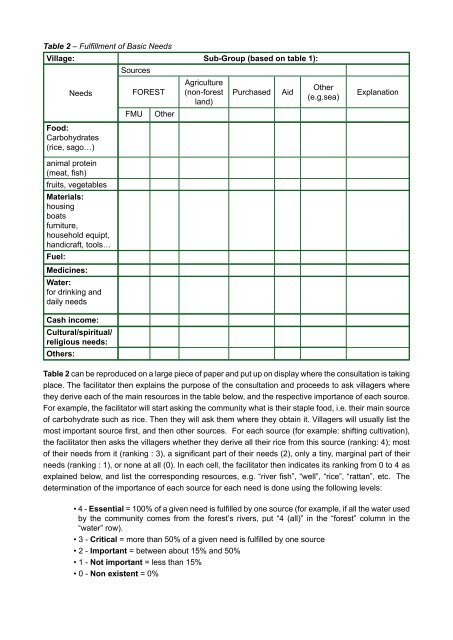(HCVF) Toolkit for Malaysia - HCV Resource Network
(HCVF) Toolkit for Malaysia - HCV Resource Network
(HCVF) Toolkit for Malaysia - HCV Resource Network
You also want an ePaper? Increase the reach of your titles
YUMPU automatically turns print PDFs into web optimized ePapers that Google loves.
Table 2 – Fulfillment of Basic Needs<br />
Village: Sub-Group (based on table 1):<br />
Needs<br />
Food:<br />
Carbohydrates<br />
(rice, sago…)<br />
Sources<br />
FOREST<br />
FMU<br />
Other<br />
Agriculture<br />
(non-<strong>for</strong>est<br />
land)<br />
Purchased<br />
Aid<br />
Other<br />
(e.g.sea)<br />
Explanation<br />
animal protein<br />
(meat, fish)<br />
fruits, vegetables<br />
Materials:<br />
housing<br />
boats<br />
furniture,<br />
household equipt,<br />
handicraft, tools…<br />
Fuel:<br />
Medicines:<br />
Water:<br />
<strong>for</strong> drinking and<br />
daily needs<br />
Cash income:<br />
Cultural/spiritual/<br />
religious needs:<br />
Others:<br />
Table 2 can be reproduced on a large piece of paper and put up on display where the consultation is taking<br />
place. The facilitator then explains the purpose of the consultation and proceeds to ask villagers where<br />
they derive each of the main resources in the table below, and the respective importance of each source.<br />
For example, the facilitator will start asking the community what is their staple food, i.e. their main source<br />
of carbohydrate such as rice. Then they will ask them where they obtain it. Villagers will usually list the<br />
most important source first, and then other sources. For each source (<strong>for</strong> example: shifting cultivation),<br />
the facilitator then asks the villagers whether they derive all their rice from this source (ranking: 4); most<br />
of their needs from it (ranking : 3), a significant part of their needs (2), only a tiny, marginal part of their<br />
needs (ranking : 1), or none at all (0). In each cell, the facilitator then indicates its ranking from 0 to 4 as<br />
explained below, and list the corresponding resources, e.g. “river fish”, “well”, “rice”, “rattan”, etc. The<br />
determination of the importance of each source <strong>for</strong> each need is done using the following levels:<br />
• 4 - Essential = 100% of a given need is fulfilled by one source (<strong>for</strong> example, if all the water used<br />
by the community comes from the <strong>for</strong>est’s rivers, put “4 (all)” in the “<strong>for</strong>est” column in the<br />
“water” row).<br />
• 3 - Critical = more than 50% of a given need is fulfilled by one source<br />
• 2 - Important = between about 15% and 50%<br />
• 1 - Not important = less than 15%<br />
• 0 - Non existent = 0%

















